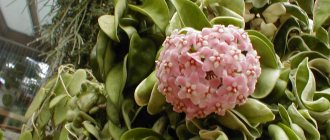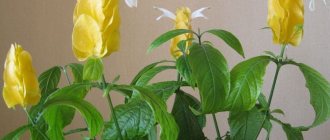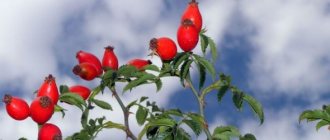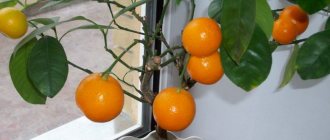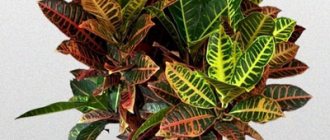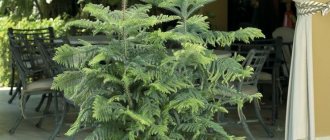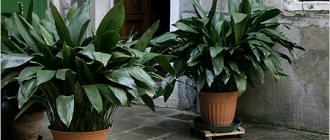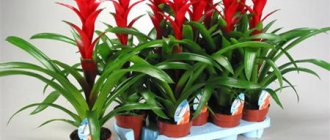Sansevieria or Sansevieria is one of the champions in oxygen production among houseplants; at the same time, this plant absorbs substances harmful to health from the air. For its striped, hard and long leaves, Sansevieria has received the popular name “pike tail”. Sansevieria is unpretentious in care and is successfully grown by novice gardeners. This plant is very decorative, looks impressive indoors, and is often grown at home, in offices and winter gardens.
basic information
Much has changed since the unprecedented popularity of this flower; a huge number of more spectacular and exotic “pets” have appeared, displacing Sansevieria on its pedestal. However, breeders did not leave “mother-in-law’s tongue” without attention and, based on it, developed many decorative, hybrid forms that attract interested glances.
This evergreen stemless plant belongs to the Asparagus family and the flower genus consists of almost six dozen species. You can meet it in its natural environment in Asian and African deserts, semi-deserts and savannas. As a house plant, flower growers grow it in different parts of the world and everywhere Sansevieria is given another, poetic name, calling it “pike tail”, “leopard lily”, “cuckoo tail”, “Indian sword”, “snake skin” and even “African hemp" and "the tongue of the devil." In addition, there are several Latin variants, in addition to sansevieria these are sansevieria and sansevieria.
Botanical description and origin of Sansevieria
Sansevieria is native to South Africa - subtropical regions. Later it was discovered in India, then on the island of Madagascar and South Florida. In its native countries, ropes and ropes are woven from it, and durable fabrics are made. Grows in rocky and sandy areas.
The name "Sansevieria" (or "Sansevieria"), the plant received in honor of Prince Sanseviero from Italy in the 18th century, who made a great contribution to the development of botany. Then from Europe it spread to Russia, where they began to grow it as a home crop. At the initial stage of research, the plant was attributed to the Agave family, later classified into Asparagus.
Other names for Sansevieria:
- in Russia, people more often call the plant mother-in-law's tongue or pike tail;
- the English call it leopard lily, snake plant or devil's tongue;
- Americans - snake skin;
- in Germany people call the flower African hemp.
No matter how many nicknames people come up with, the plant remains one of the great succulents. It has properties similar to Agave, from which Mexican Tequila is made.
There are more than 60 species of Sansevieria in nature. There is a feature that unites them with each other - the absence of a stem. They differ in leaf shape (flat and round), color, root system. For the purpose of interior decoration, breeders are breeding an increasing number of species and varieties.
Beneficial properties of sansevieria
Sansevieria perfectly purifies the air from various harmful impurities. In particular, it effectively removes benzene and trichlorethylene. To significantly improve the environmental situation, only 2-3 medium-sized plants are enough. They can be placed in any room, except the bedroom. Also, the “pike tail” secretes phytoncides that destroy pathogenic microorganisms.
The long leaves of the plant are often called “mother-in-law’s tongue.” According to some superstitions, they encourage people to gossip. In fact, everything is exactly the opposite. Sansevieria has the ability to cleanse the surrounding space of various negativity, helps achieve set goals, and develops entrepreneurship in people.
Diseases, pests and their control
“Mother-in-law’s tongue” is strong and hardy, however, there are threats to its growth: The most common disease is rot
| Rot | Manifestation | Routes of infection |
| Soft | Softening of the base of the socket, smell of rotten fish. | Buying an already diseased flower, high air humidity. |
| Root | Multi-colored spots that take on non-standard shapes. | Water ingress on the base of the socket, diseased ground. |
| Leafy | Dark circles with spores. | Excessive moisture. |
The plant is also susceptible to parasites:
| Pest | Manifestation | Struggle |
| Spider mite | Yellowing, leaves fade and die. | Spray with a decoction of orange peels or Fitoverm. |
| Trips | Loss of natural color, brown color and metallic sheen. | Treat with insecticides. |
| Mealybug | Leaf falling, lethargy, change in color and shape. | Worms settle at the base. They must be selected and disposed of. In case of severe damage, treatment with karbofos is recommended. |
Reproduction
Sansevieria at home is most often propagated vegetatively: by dividing the bush (lateral layering), dividing the rhizome or leaf cuttings.
When dividing a bush, the rhizome connecting the parent plant with the shoot is cut with a sharp knife; this rhizome is quite strong. The cut is sprinkled with crushed coal, placed in a separate pot with fresh soil, and watered. In the future, watering should be careful, not excessive. You should refrain from feeding for a month. As a rule, layerings take root well.
It is more difficult to propagate sansevieria by leaf, but the advantage of this method is that you can get several new plants at the same time.
Leaves for cuttings must be sufficiently mature and healthy. Usually the old lower leaves are taken. Leaf cuttings 5-10 cm long are dried in air for two days, then placed vertically in damp sand, peat or vermiculite, buried by 1.5-2 cm. A distance of 2-4 cm is left between the cuttings. The soil is lightly compacted so that the cuttings stayed in it. Cover the top with a jar or bag, removing them once a day for ventilation, and moisten the substrate as it dries. The container with the cuttings is placed in a bright, warm place without direct sun.
After about 2-3 weeks, roots appear on the cuttings, after 1-2 months - babies, after 2-3 months - stem cuttings, which can be planted in separate small pots. Water carefully, without flooding.
Important: when variegated varieties of Sansevieria are propagated by leaves, the varietal characteristics of the parent - colored stripes on the leaves - are not transmitted to the daughter plant. Therefore, it is better to propagate such species by dividing the bush.
Another way to propagate sansevieria is by dividing the rhizome. For propagation, take an adult plant with a developed rhizome. Dry roots are peeled off the rhizome and cut into pieces, each with at least one bud. The sections are treated with a fungicide or sprinkled with crushed coal and placed in the substrate.
Sansevieria propagation
Rhizome division
Sansevieria is propagated by dividing the rhizome, lateral shoots and dividing the leaf. The most convenient way to divide the rhizome of a plant is during spring replanting: use a sharp knife to cut the rhizome so that a growing point remains on each part. Place the divided sansevieria in different pots and place them in a warm place. Water sparingly. This method is suitable for both monochromatic and variegated types of sansevieria.
Reproduction by leaf division
Also a simple procedure. The old leaf is cut into pieces 4-5 cm long, dried a little in the air, then the lower end is immersed in sand at an angle of 45º, covered with a jar or cut-off plastic bottle and, with moderate bottom watering (water is poured into the tray of the pot), rooted.
After 30-40 days, as soon as the leaf takes root and produces buds from which young leaves appear, the plant is transplanted into a pot with soil. This method is suitable only for monochromatic species of sansevieria: even if you root a striped leaf, the baby will still grow green.
Soil preparation
Sansevierias are replanted once a year, if the plant is still young. If the sansevieria is more than two years old, then the transplant is carried out once every three years. It is best to replant in the spring. The indoor plant has a very extensive root system, so the pot must be selected taking into account the fact that the roots will grow and may begin to destroy the container. In order to prepare the soil for transplanting sansevieria, you need to take four parts of leaf soil, one part of turf soil and one part of sand. It is also possible to add peat or humus. It is necessary to ensure very good drainage for the plant.
What kind of soil does sansevieria need?
The plant does not like acidic soils - the skin on the flower cracks due to the high nitrogen content. The best option is soil with a neutral pH (6-7). The loose, light structure provides good aeration to the roots.
Sansevieria
The substrate for transplanting sansevieria is prepared according to the following recipe:
- add the same amount of sand to the 1st part of peat;
- add 3 parts of turf or leaf soil, as well as ½ part of humus;
- add a little vermiculite or perlite to the mixture (to absorb excess moisture);
- the substrate is poured into a pot and used to transplant the flower.
You can also take a different soil composition: from sand, deciduous and turf soil in a ratio of 2:2:6, respectively.
Planting and further care
Sansevieria is unpretentious and requires minimal care at home. The plant easily tolerates moisture deficiency, so watering should be moderate. Make sure the soil has time to dry. In winter, watering once a week is sufficient. It is important not to pour water into the center of a bunch of leaves, as this can lead to the formation of crusty spots and further rotting of the leaves. But, the cut leaves of the plant can be placed in a vase with water if the situation requires it. At the same time, Sansevieria will be able to stand in the water for some time and not rot, even take root and continue to grow, but this will not last long. It should also be noted that sansevieria calmly tolerates watering with hard water and the high lime content in the soil does not bother it.
Pots with sansevieria can be placed near heating radiators; the plant also tolerates summer heat well. As for the cold, a temperature of +8 degrees is considered the minimum for normal growth of sansevieria. The plant loves light very much, but can live in the shade for some time. In winter, it is better to choose a bright room for sansevieria. If such a need arises, you can feed the sansevieria with regular fertilizers for indoor plants. But it's important not to overdo it. It is believed that with excessive feeding, the leaves may fade and lose their bright color. This indoor plant does not require spraying at all. It is enough to occasionally wipe the leaves of the plant with the soft side of a damp sponge.
Feeding
For active growth and beautiful appearance, Sansevieria needs feeding. You can use fertilizers for decorative foliage plants or for succulents with a predominance of nitrogen, as well as phosphorus, potassium, calcium, sulfur and magnesium. Liquid fertilizers are diluted weaker than recommended - if there is an excess of nitrogen, which is important for the plant, the pattern on the leaves disappears.
Fertilizing is done no more than once a month, and better – once every one and a half to two months.
Granular fertilizers with slow release of nutrients have proven themselves well.
Sansenvieria Hanni (Sansiviera Hahnii)
Types and varieties
Sansevieria grandis (Large)
The plant is a perennial, the rosette is usually formed from 4 leaves, the length of which varies from 35 to 70 cm. The width of the leaf can reach up to 17 cm. The leaves have a pattern in the form of darkish transverse stripes, the edges of the leaf have a reddish border.
Sansevieria hyacinthoides (Hyacinth)
The height of the plant reaches up to 60 cm, the leaves are arranged in a rosette containing 3-4 leaves. The length of the leaves varies from 12 to 45 cm, the width is no more than 8 cm. The leaves have a lush green color with the inclusion of light wavy strokes. The edges of the leaves are colored light or reddish.
Sansevieria dooneri (Dooneri)
A plant with rosettes which usually have from 16 to 20 leaves. The length of the leaf reaches 40 cm, the width is quite scanty, only 3 cm. The leaves are rich green with a small pattern in dark colors.
Sansevieria gracilis (Graceful)
A perennial plant, its height reaches up to 6 cm. The leaves are green, oval in shape and slightly pointed towards the end. The leaves have a pattern in the form of grayish transverse streaks.
Sansevieria kirkii (Kirki)
A plant with a weak root system; the rosettes contain a small number of leaves. The color of the leaves is bright green with a light pattern and red edging along the entire perimeter of the leaf.
Sansevieria liberica (Liberian)
A plant with large rosettes, inside of which there are up to 6 leaves. The long leaf can reach more than 1 meter, the width is no more than 9 cm. The leaves are dark green in color, with a bright and light pattern in the form of blurry strokes. The edge of the leaves always has a brown or white edging.
Sansevieria trifasciata (three-banded)
Quite a strong and tall plant, with green leaves and a yellow border around the entire perimeter. There are quite a lot of leaves in the rosette.
Varieties of Sansevieria
The culture is divided into large and compact forms. The first is used to decorate large interior spaces, the second is used in compositions with other plants. Several varieties are distinguished for indoor keeping.
- "Sansevieria three-lane" (Laurenti). A very large, powerful plant. Reaches a height of up to one meter. The leaves are striped with a bright edge. The color and shape are greatly influenced by the color of the sun. If there is too much of it, the plant will lighten. With a lack of lighting, watering, and poor soil, the leaves become dark green in color and the stripes become less pronounced. It blooms very rarely. This depends primarily on the availability of sunlight.
- "Sansevieria cylindrica" (Cylindrica). The variety is similar to another species similar to it - “Twister”. The curled leaves are tube-shaped with good natural flexibility, similar to the feathers of green onions. The stripes are transverse. The cylinder is practically not demanding of lighting, but it still blooms under the influence of sunlight. Grows in height up to 1.5 m.
- "Hanny" is a dwarf variety. Used successfully in compositions. Flower growers like to display it on narrow window sills, since its dimensions fit perfectly into a small space. The leaves are short, the stripes are horizontal. There are several types of this variety (see photo) - “Gold” and “Silver”. In the first case, the species is distinguished by stripes with a golden tint. In the second, silver color predominates. The more light there is, the more noticeable this “pike” color is displayed.
- "Black-Gold". It has thin dark green leaves with a bright light edge.
- "Pick". It is distinguished by its extraordinary shape of leaves, similar to ruffles with an unusual beautiful pattern. The color comes in different shades: dark green, light brown. This is a rare species of domestic sansevieria.
- "Big." It stands out among others because of its size and shape of its leaves, which are the width of an adult’s palm. It grows up to one and a half meters in height.
- "Dunery." A distinctive feature from other varieties is the rosette, which forms 10-15 narrow leaves with flat dark stripes. The variety is low-growing, up to 25 cm high. Rarely used for interior decoration.
- "Hyacinth" The leaves are large, up to one meter high. It stands out from other varieties due to its active, long-lasting flowering.
Growing problems
There are no big difficulties when growing sansevieria; it is a very flexible plant. But sometimes some problems may arise.
Dark spots on the leaves are due to waterlogging at low temperatures.
The leaves are turning yellow. The plant does not have enough light. Perhaps the pot is too tight.
The leaves are soft along their entire length and bend in half or deviate greatly from the vertical. Most likely, the sansevieria does not have enough light, so the leaves are very elongated and cannot support their own weight.
The leaves become soft at the base and begin to turn yellow. Perhaps water got into the center of the outlet and a fungal disease began.
The tips of the leaves wither, turn yellow and dry out. The plant is too cold, it may be overwatered or there is not enough light.
The leaves are withering. The plant has not been watered for a long time.
Pests of Sansevieria
Mealybug. It is primarily found in the rosette and at the base of the leaves.
To begin with, the plant is washed in warm water, washing off the cotton wool-like coating. Then wipe the pest accumulation areas with a cotton swab dipped in alcohol. If possible, treat the plant with Actellik or Fufanon (3).
Thrips. They settle on the underside of leaves and feed on plant juices. The leaves take on a grayish-brown hue with a silvery sheen.
To protect the plant, spray 2-3 times with an interval of 10-14 days with Actellik (3).
Shield. It is easy to detect by looking closely at the leaves - it looks like dense brownish tubercles.
To begin with, pests are collected by hand, then the leaves are wiped with a cotton pad soaked in alcohol. If possible, plants are sprayed twice with an interval of 10 - 14 days with Actellik or Fitoverm (3).
Caring for Sansevieria at home
Lighting
Sansevieria will not die in low light conditions, but you should not constantly keep it in the back of the room. For a plant to be beautiful, with developed and bright leaves, it needs a lot of light, including sunlight. Only if the plant is placed on a south-facing window will it require shading on hot summer days.
For variegated varieties, the lighting requirements are somewhat different. If the proportion of yellow in the color is large enough, the plant needs less light; its excess can turn variegated leaves into ordinary green ones. But in low light conditions the plant will develop poorly, so for such varieties you need to choose an intermediate position relative to the window. Be sure to protect them from direct sun, as the colored areas of the leaves are more susceptible to sunburn.
Temperature
The plant is not very picky about temperature; Sansevieria feels most comfortable at 16-20 degrees at night, and 21-28 degrees during the day, but can withstand higher temperatures. If you are in cool conditions for a long time (for example, in winter in the passages of office buildings), you need to significantly reduce watering.
Watering
Sansevieria is a drought-resistant plant, succulent. Water it lightly; the next watering should be done when the soil dries out. The plant can withstand relatively long periods without water.
When watering, you need to make sure that water does not get inside the outlet, which could rot.
When the room temperature is low, Sansevieria needs to be watered less frequently; less frequent watering is also required if the plant is placed in the shade.
Sansevieria does not need spraying, but periodically you need to clean the leaves from dust using a cloth or a special broom.
Transfer
Sansevieria is replanted as the plant grows. Young plants can be replanted annually, adults - once every few years, when the pot becomes crowded. The new pot is shallow, 1.5-2 cm wider than the old one, sansevieria does not like a large volume of soil, and its root system is superficial and shallow.
Sansevieria needs light, low-nutrient soil that dries quickly. It is better to use specialized soil mixtures for cacti and succulents or make your own soil from leaf, turf soil and sand in equal parts. If the soil is prepared independently, it is advisable to calcinate it in the oven or steam it.
Top dressing
From May to September, sansevieria is fed once every 2 weeks. The rest of the time, you can apply fertilizer once a month, but during cool wintering you should not feed the plant at all. For feeding, use fertilizers for cacti and succulents or universal mineral fertilizer. For variegated varieties, do not use fertilizers with a high nitrogen content, which stimulates the production of chlorophyll and, as a result, greening of the leaves.
Does it make sense to buy ready-made land and what is the cost?
Professional flower growers and gardeners like to prepare soil for planting sansevieria on their own, but novice gardeners can be advised to buy ready-made soil compositions in the store.
You should take soil for succulents, which contains peat . If the composition contains heavier lowland peat, it can quickly cake, so it is better to dilute store-bought soil with sand.
- In Moscow, the price of ready-made soil for succulents is 80 rubles.
- In St. Petersburg , the price is almost the same, but it all depends on the manufacturers, whose prices may differ.
If you decide to grow sansevieria, we recommend that you read our articles on planting, replanting and caring for the plant, and from our materials you will learn at what time and for how long the pike tail blooms.
Medicinal, beneficial properties of sansevieria, “mother-in-law’s tongue”, “pike tail”
Healing properties of sansevieria (“mother-in-law’s tongue”, “pike tail”). Treatment of colds, treatment of otitis media, treatment of gastrointestinal diseases.
Sansevieria is native to Africa and tropical Asia, where it grows in savannas, semi-deserts and even deserts. Sansevieria is an unpretentious stemless plant of the lily family; it has erect, sharp, lanceolate, dense, dark green basal leaves up to 1 m or more long, with transverse yellowish or light green stripes. The rhizome is creeping, powerful. Sansevieria blooms with fragrant, sticky nectar-producing pale green flowers, almost white, with narrow petals and long stamens. The flowers are located on a long peduncle-arrow.
Sansevieria contains a number of biologically active substances, but the most important of them for humans are saponins - highly toxic substances that, when used properly, can bring great benefits.
In traditional medicine, saponins are used in the production of laxatives, choleretic, expectorants, and anti-inflammatory drugs. In folk
In medicine, sansevieria is used for cystitis and adnexitis, otitis, and inflammation of the throat and oral cavity. It helps increase immunity, stress resistance, and improve the general condition of the body. You can use it for cuts and bleeding. For scratches and other shallow damage to the skin, it is recommended to apply a sansevieria leaf with the side from which the skin was previously removed to the affected area. The plant, like plantain, will disinfect and stop bleeding.
Saponins are glycosides of plant origin with surfactant and foaming properties. They are practiced in cosmetology in the manufacture of detergents such as shampoos, liquid soap, etc.
It is not recommended to use sansevieria in treatment during pregnancy, since it is believed that the substances contained in this plant have abortifacient properties.
Mr. Summer Resident advises: the pros and cons of sansevieria in the house
Sansevieria is called a natural ozonizer, as it holds the record for the amount of oxygen produced. In addition, the beneficial properties of the plant are:
- Active absorption of carbon dioxide from the air.
- The release of phytoncides - volatile “antibiotics” that suppress the growth of harmful bacteria and infections in the house.
- The pulp from the leaves of the plant can help with some skin diseases.
- In China, they believe that the “tail of the fire orchid” brings peace, good luck to the house and absorbs harmful energy.
With all its advantages, the “pike tail” has several disadvantages:
- High content of saponin - a toxic substance that causes vomiting when eaten.
- Some have sharp edges and may cause harm to small children or curious animals.
- Flowers cause allergies.
Why are there limp leaves and what should I do?
- If the plant has soft, slightly shrunken leaves , this means that it has dried out and needs to be watered more often.
- If the leaf is soft and wrinkled, and turns yellow at the base , the flower has been flooded and the roots have already begun to rot. It is taken out of the pot, dried, the affected areas of the roots are removed and the soil is changed.
- Droopy leaves are the first signal of excess moisture. Watering is stopped until the soil dries completely and the turgor of the leaf plates is restored.
Sansevieria is valued for its decorative appearance, ability to purify the air from harmful substances and ease of care. Water the flower rarely and moderately, frequent feeding is not needed, and you can choose any place - this succulent grows even in the shade.
Description of Sansevieria
Succulent representatives of the genus, which are grown at home, are divided into 2 groups depending on the shape of the foliage. One includes tall plants with vertical, long sword-shaped leaves.
Blooming Sansevieria cylindrica
The second group is formed by low rosettes of spirally arranged small leaves, pointed oval, lanceolate or cylindrical.
In favorable growing conditions, it blooms once a year, producing a long peduncle with small white with a greenish tint, cream or pink flowers that have a honey aroma that intensifies in the evening and at night.
Caring for indoor chrysanthemum
After flowering, the peduncle continues to grow, giving life to basal shoots. Plants often form dense, extensive clumps that grow thanks to creeping rhizomes.
How fast does Sansevieria grow?
The question of how to transplant a pike tail rarely arises among gardeners - this plant develops very slowly. It would be more relevant to ask when this procedure should be performed.
Pike tail flower - care and reproduction
Mother-in-law's tongue (another name for the plant) can develop freely in one container for 2-3 years. Time is not a reason to move. The signal for a transplant will be the following moments:
- separate rosettes have formed on young leaves;
- the plant is cramped, roots are visible from the drain hole at the bottom of the pot;
- Sansevieria began to wither, turn yellow, curl up, curl up.
Note! The latter reason is often provoked by improper care, leading to rotting of the roots. To verify the condition of the underground part of the plant, it will have to be removed from the pot. Having tidied up the roots, it is wiser to immediately allocate a new container for the pike tail.
Features of Sansevieria
In nature, Sansevieria can be found on dry rocky soils in India, Madagascar, Africa and Indonesia. In African countries, ropes and various ropes are made from plant fibers.
Pros and benefits
- A very unpretentious plant. You can not water for a whole month, and nothing will happen to her.
- Spectacular appearance and color variations. The leaves can grow up to 1 m in height.
- Has healing properties. It contains saponins, which have anti-inflammatory, expectorant and restorative properties.
What conditions must be provided for sansevieria to bloom?
One of my favorite indoor plants is Sansevieria
- a herbaceous stemless evergreen perennial with a thick creeping rhizome and long erect, usually striped, very dense leaves.
Other names for this plant: “pike tail”
,
“mother-in-law’s tongue”
. In Japan it is called “tiger tail”, in Brazil – “sword of San Jorge”, in the Netherlands – “women’s tongue”, in Germany – “African hemp”, in France – “snake plant”.
I appreciate this plant for its amazing endurance, unpretentiousness and wonderful decorative appearance. Sansevieria requires minimal care and is highly resistant to diseases and pests - only very weakened plants are affected by spider mites and scale insects. One day I was making tea and accidentally scalded the leaves of a sansevieria growing in our kitchen with hot steam. Of course, I was very upset. But, to my surprise and great joy, the plant was not damaged at all - the steam from the boiling kettle did not leave a burn or even the slightest trace on the leaves!
In some countries, for example, in Brazil, Portugal, and African countries, the indigenous population uses this plant as protection from evil, the evil eye and various obsessions (for this, sansevieria is usually placed at the entrance to the house). In addition, leaf fibers were previously used to make bow strings and ropes. And now sansevieria is cultivated in some areas as a valuable industrial crop (for fiber production).
NASA research has shown that Sansevieria is one of the best plants that effectively purifies indoor air and improves its quality. Sansevieria removes harmful substances released from new furniture, various building materials, synthetic home furnishings, etc. The plant absorbs toxins such as nitrogen oxides, formaldehyde and benzene, removes carbon dioxide, and actively releases oxygen at night. Since Sansevieria is a natural air purifier, it is recommended to place it in the bedroom and kitchen.
At the same time, some Portuguese researchers consider the plant juice to be toxic. Poisoning occurs when the juice enters the bloodstream and when it is swallowed in large quantities, in these cases the following symptoms are possible: abdominal pain, vomiting, diarrhea, which disappear after some time. Since, fortunately, I have not had to deal with these negative manifestations, I prefer to consider the plant only as an amazing gift for a novice gardener.
Sansevieria as a potted plant is an excellent option for decorating your home and office. Leaves are used cut to create various compositions. After the cut leaves of the composition standing in water have roots, they can be planted in the soil substrate.
Distribution of Sansevieria
Under natural conditions, plants of the genus Sansevieria grow in areas with dry tropical and subtropical climates - Africa, Asia, Central and South America, Australia, forming dense thickets. Stiff leaves grow vertically from a rosette; a creeping underground rhizome sometimes reaches the soil surface. In nature, Sansevieria grows well in sandy soil, soil with gravel, for example, in deserts, semi-deserts and savannas.
Description of the plant
Plants of the genus Sansevieria usually have dense, long, erect, gathered in a basal rosette, green, dark green or silvery leaves with various decorative colored stripes (transverse or longitudinal). Depending on the variety, the stripes on the leaves of sansevieria can be white, light gray, light gray-green, silver-white, bright yellow, yellow, golden, etc.
The height of the plant, depending on the variety, is 12-150 cm - there are low-growing, medium-growing and tall varieties, leaf width is 5-9 cm.
As a rule, flowering sansevierias are quite large specimens. Their flowers are small, greenish-white (or white-pink, some have a pearlescent tint), with narrow curling petals and long stamens, inconspicuous, but very fragrant (their aroma is delicate and pleasant, usually intensifies in the evening), producing nectar, collected in an inflorescence raceme. A flower arrow 15-20 cm long, emerging from the center of the rosette, appears between the leaves. Flowering does not last long, after which the wilted arrow needs to be removed.
It should be noted that Sansevieria blooms infrequently and irregularly and only under favorable conditions. I have not yet been able to trace its seasonal pattern.
Diseases and pests
The plant may become sick due to frequent watering, in which case yellowing and wilting of the leaves will occur. To save the flower, diseased leaves should be removed and transplanted into another pot with clean soil.
Despite its love for the sun, it can have a negative effect on sansevieria, namely, dark or, conversely, white spots may appear on the leaves from an excess of sunlight.
In rare cases, a flower may be affected by a mealybug or mite. To control pests, insecticides and frequent ventilation of the room are used.
Comments (6)
Maryana
05.12.2017 at 13:57 |
We have a sansevieria in the living room along with a couple of other plants. It is easy to care for, I personally don’t have much trouble with it, but it looks beautiful and decorates the interior.Answer
Masha
12/19/2017 at 01:32 |
I have Sansevieria growing in my kitchen. Fluctuations in temperature and humidity do not harm it. Resistant to rare watering and rot. Plant No. 1 for lazy housewives.
Answer
Yulia Expert Plodogorod
12/12/2019 at 22:06 |
Hello, Masha! Although this is indeed a very unpretentious plant, you should not completely forget about caring for sansevieria. Although the plant is not demanding on temperature, strong fluctuations can worsen immunity. It is better that the temperature in the room where the crop is located does not fall below 16-17 degrees, otherwise the plant may be depressed.
If for some reason the room is colder, it is important to significantly reduce watering. It is not advisable to keep the flower in the cold for a long time.
A flower can really survive without moisture for a long time. But, it is better to moisten a few days after the earthen clod has completely dried out. It is important that moisture does not get inside the outlet.
This can just lead to rotting of the rhizome, and, consequently, the death of the crop. The flower also does not tolerate stagnation of water at the roots. Therefore, it is important not only to observe the correct watering regime, but also to initially use suitable soil and establish drainage.
Spraying is not recommended; wiping the crown with a damp cloth while sweating will have a positive effect on the condition and decorativeness of the plant. It is important that dust does not settle on the leaves.
If too much moisture is added, the crown may become covered with dark spots. Yellowing of the leaves of a variety for which this is not typical indicates a lack of lighting. Also, when a flower does not have enough sun, the foliage can become very stretched and bend in half under its own weight.
If the leaves begin to become smaller and yellow in the central part of the rosette, most likely moisture got there during the moistening process, and the development of a fungal disease began. It is important to start treatment immediately.
Yellowing and dry areas on the crown indicate low temperatures. If conditions are not improved, the culture will slowly die. If the leaves are flaccid and lose turgor, the flower lacks moisture. It is worth adjusting the watering.
Answer
Angelina
12/19/2017 at 02:42 pm |
I agree that this plant is not fussy and does not need frequent watering. For me it’s the perfect plant. I have a sansevieria plant in my kitchen near the window. Both in winter and summer she has enough warmth and light. It doesn’t require any special attention, I spray it with water once a week and it pleases me with its rich color and lush growth.
Answer
Irina
02/18/2018 at 00:20 |
I have several sansevierias growing in my apartment - they always delight me with their beautiful blooms and aroma in the summer. It is easy to care for and needs to be watered infrequently. I feed it with fertilizer every week.
Answer
Yulia Expert Plodogorod
12.12.2019 at 21:45 |
Hello Irina! Blooming Sansevieria is quite a rare occurrence. This usually indicates good care of the plant. Important elements of care for such a plant to begin to bloom are an abundance of light and good ventilation in the room where the plant is located. The musty air depresses even such a hardy crop.
The main factor that contributes to the appearance of flower stalks is a large amount of sunlight. Therefore, by placing the described plant on a southern or western window, the likelihood of getting fragrant buds increases. Such conditions also increase the decorativeness of the crown.
But, it is better to hide even such drought-resistant plants from the scorching summer sun. The buds resemble stars in a light green or white hue. Most species have a strong odor. It can provoke dizziness and headaches. Therefore, it is better not to place blooming sansevieria in bedrooms.
Although the flowering looks quite original, there is an important nuance. The rosette of the described culture is capable of blooming only once during the entire period of its existence.
When flowering ends, the described rosette stops developing and then begins to slowly die. Such sockets are suitable only for reproduction. For this reason, artificial stimulation of flowering may in the future negatively affect the decorativeness of the crop as a whole.
When flowering ends, it is better to remove the flower stalks.
As for fertilizing, it is better not to apply it so often. Excess nutrients in a small pot space can cause burns and softening of the roots. It is worth applying fertilizing during the period of active development, that is, in summer and spring days.
The best option would be a special mineral product for succulents or decorative foliage varieties. The chosen means must be balanced. You should beware of excess nitrogen.
Once a week is too often for the colors described. The optimal frequency of fertilizing for sansevieria is once every 4 weeks. In addition, it is better to reduce the dosage by half of that recommended by the fertilizer manufacturer.
If your sansevieria have a variegated color, pattern, stripes or edging on the leaves, you need to reduce the dosage even more - three times from the recommended one. Excess nutrients can lead to loss of decorative properties. The crown will become monochromatic.
Answer
